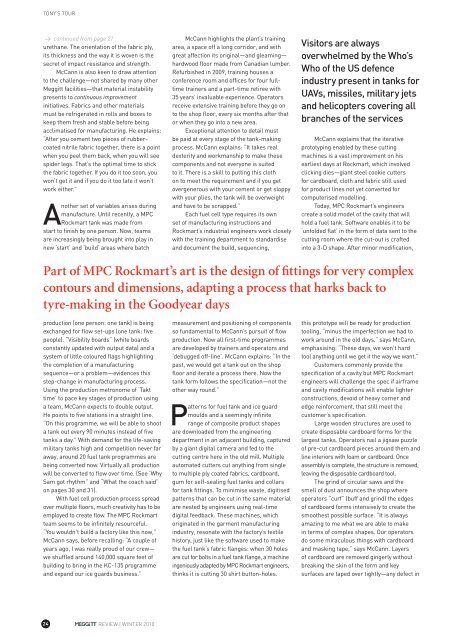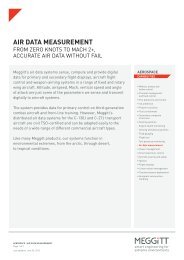In the beginning there was an altimeter - Meggitt PLC
In the beginning there was an altimeter - Meggitt PLC
In the beginning there was an altimeter - Meggitt PLC
You also want an ePaper? Increase the reach of your titles
YUMPU automatically turns print PDFs into web optimized ePapers that Google loves.
TONY’S TOUR<br />
> continued from page 21<br />
ureth<strong>an</strong>e. The orientation of <strong>the</strong> fabric ply,<br />
its thickness <strong>an</strong>d <strong>the</strong> way it is woven is <strong>the</strong><br />
secret of impact resist<strong>an</strong>ce <strong>an</strong>d strength.<br />
McC<strong>an</strong>n is also keen to draw attention<br />
to <strong>the</strong> challenge—not shared by m<strong>an</strong>y o<strong>the</strong>r<br />
<strong>Meggitt</strong> facilities—that material instability<br />
presents to continuous improvement<br />
initiatives. Fabrics <strong>an</strong>d o<strong>the</strong>r materials<br />
must be refrigerated in rolls <strong>an</strong>d boxes to<br />
keep <strong>the</strong>m fresh <strong>an</strong>d stable before being<br />
acclimatised for m<strong>an</strong>ufacturing. He explains:<br />
“After you cement two pieces of rubbercoated<br />
nitrile fabric toge<strong>the</strong>r, <strong>the</strong>re is a point<br />
when you peel <strong>the</strong>m back, when you will see<br />
spider legs. That’s <strong>the</strong> optimal time to stick<br />
<strong>the</strong> fabric toge<strong>the</strong>r. If you do it too soon, you<br />
won’t get it <strong>an</strong>d if you do it too late it won’t<br />
work ei<strong>the</strong>r.”<br />
Ano<strong>the</strong>r set of variables arises during<br />
m<strong>an</strong>ufacture. Until recently, a MPC<br />
Rockmart t<strong>an</strong>k <strong>was</strong> made from<br />
start to finish by one person. Now, teams<br />
are increasingly being brought into play in<br />
new ‘start’ <strong>an</strong>d ‘build’ areas where batch<br />
production (one person: one t<strong>an</strong>k) is being<br />
exch<strong>an</strong>ged for flow set-ups (one t<strong>an</strong>k: five<br />
people). “Visibility boards” (white boards<br />
const<strong>an</strong>tly updated with output data) <strong>an</strong>d a<br />
system of little coloured flags highlighting<br />
<strong>the</strong> completion of a m<strong>an</strong>ufacturing<br />
sequence—or a problem—evidences this<br />
step-ch<strong>an</strong>ge in m<strong>an</strong>ufacturing process.<br />
Using <strong>the</strong> production metronome of ‘Takt<br />
time’ to pace key stages of production using<br />
a team, McC<strong>an</strong>n expects to double output.<br />
He points to five stations in a straight line.<br />
“On this programme, we will be able to shoot<br />
a t<strong>an</strong>k out every 90 minutes instead of five<br />
t<strong>an</strong>ks a day.” With dem<strong>an</strong>d for <strong>the</strong> life-saving<br />
military t<strong>an</strong>ks high <strong>an</strong>d competition never far<br />
away, around 20 fuel t<strong>an</strong>k programmes are<br />
being converted now. Virtually all production<br />
will be converted to flow over time. (See ‘Why<br />
Sam got rhythm” <strong>an</strong>d “What <strong>the</strong> coach said”<br />
on pages 30 <strong>an</strong>d 31).<br />
With fuel cell production process spread<br />
over multiple floors, much creativity has to be<br />
employed to create flow. The MPC Rockmart<br />
team seems to be infinitely resourceful.<br />
“You wouldn’t build a factory like this now,”<br />
McC<strong>an</strong>n says, before recalling: “A couple of<br />
years ago, I <strong>was</strong> really proud of our crew—<br />
we shuffled around 140,000 square feet of<br />
building to bring in <strong>the</strong> KC-135 programme<br />
<strong>an</strong>d exp<strong>an</strong>d our ice guards business.”<br />
00 24<br />
REVIEW | WINTER 2010<br />
McC<strong>an</strong>n highlights <strong>the</strong> pl<strong>an</strong>t’s training<br />
area, a space off a long corridor, <strong>an</strong>d with<br />
great affection its original—<strong>an</strong>d gleaming—<br />
hardwood floor made from C<strong>an</strong>adi<strong>an</strong> lumber.<br />
Refurbished in 2009, training houses a<br />
conference room <strong>an</strong>d offices for four fulltime<br />
trainers <strong>an</strong>d a part-time retiree with<br />
35 years’ invaluable experience. Operators<br />
receive extensive training before <strong>the</strong>y go on<br />
to <strong>the</strong> shop floor, every six months after that<br />
or when <strong>the</strong>y go into a new area.<br />
Exceptional attention to detail must<br />
be paid at every stage of <strong>the</strong> t<strong>an</strong>k-making<br />
process. McC<strong>an</strong>n explains: “It takes real<br />
dexterity <strong>an</strong>d workm<strong>an</strong>ship to make <strong>the</strong>se<br />
components <strong>an</strong>d not everyone is suited<br />
to it. There is a skill to putting this cloth<br />
on to meet <strong>the</strong> requirement <strong>an</strong>d if you get<br />
overgenerous with your cement or get sloppy<br />
with your plies, <strong>the</strong> t<strong>an</strong>k will be overweight<br />
<strong>an</strong>d have to be scrapped.”<br />
Each fuel cell type requires its own<br />
set of m<strong>an</strong>ufacturing instructions <strong>an</strong>d<br />
Rockmart’s industrial engineers work closely<br />
with <strong>the</strong> training department to st<strong>an</strong>dardise<br />
<strong>an</strong>d document <strong>the</strong> build, sequencing,<br />
measurement <strong>an</strong>d positioning of components<br />
so fundamental to McC<strong>an</strong>n’s pursuit of flow<br />
production. Now all first-time programmes<br />
are developed by trainers <strong>an</strong>d operators <strong>an</strong>d<br />
‘debugged off-line’. McC<strong>an</strong>n explains: “<strong>In</strong> <strong>the</strong><br />
past, we would get a t<strong>an</strong>k out on <strong>the</strong> shop<br />
floor <strong>an</strong>d iterate a process <strong>the</strong>re. Now <strong>the</strong><br />
t<strong>an</strong>k form follows <strong>the</strong> specification—not <strong>the</strong><br />
o<strong>the</strong>r way round.”<br />
Patterns for fuel t<strong>an</strong>k <strong>an</strong>d ice guard<br />
moulds <strong>an</strong>d a seemingly infinite<br />
r<strong>an</strong>ge of composite product shapes<br />
are downloaded from <strong>the</strong> engineering<br />
department in <strong>an</strong> adjacent building, captured<br />
by a gi<strong>an</strong>t digital camera <strong>an</strong>d fed to <strong>the</strong><br />
cutting centre here in <strong>the</strong> old mill. Multiple<br />
automated cutters cut <strong>an</strong>ything from single<br />
to multiple ply coated fabrics, cardboard,<br />
gum for self-sealing fuel t<strong>an</strong>ks <strong>an</strong>d collars<br />
for t<strong>an</strong>k fittings. To minimise <strong>was</strong>te, digitised<br />
patterns that c<strong>an</strong> be cut in <strong>the</strong> same material<br />
are nested by engineers using real-time<br />
digital feedback. These machines, which<br />
originated in <strong>the</strong> garment m<strong>an</strong>ufacturing<br />
industry, resonate with <strong>the</strong> factory’s textile<br />
history, just like <strong>the</strong> software used to make<br />
<strong>the</strong> fuel t<strong>an</strong>k’s fabric fl<strong>an</strong>ges: when 30 holes<br />
are cut for bolts in a fuel t<strong>an</strong>k fl<strong>an</strong>ge, a machine<br />
ingeniously adapted by MPC Rockmart engineers,<br />
thinks it is cutting 30 shirt button-holes.<br />
Visitors are always<br />
overwhelmed by <strong>the</strong> Who’s<br />
Who of <strong>the</strong> US defence<br />
industry present in t<strong>an</strong>ks for<br />
UAVs, missiles, military jets<br />
<strong>an</strong>d helicopters covering all<br />
br<strong>an</strong>ches of <strong>the</strong> services<br />
McC<strong>an</strong>n explains that <strong>the</strong> iterative<br />
prototyping enabled by <strong>the</strong>se cutting<br />
machines is a vast improvement on his<br />
earliest days at Rockmart, which involved<br />
clicking dies—gi<strong>an</strong>t steel cookie cutters<br />
for cardboard, cloth <strong>an</strong>d fabric still used<br />
for product lines not yet converted for<br />
computerised modelling.<br />
Today, MPC Rockmart’s engineers<br />
create a solid model of <strong>the</strong> cavity that will<br />
hold a fuel t<strong>an</strong>k. Software enables it to be<br />
‘unfolded flat’ in <strong>the</strong> form of data sent to <strong>the</strong><br />
cutting room where <strong>the</strong> cut-out is crafted<br />
into a 3-D shape. After minor modification,<br />
Part of MPC Rockmart’s art is <strong>the</strong> design of fittings for very complex<br />
contours <strong>an</strong>d dimensions, adapting a process that harks back to<br />
tyre-making in <strong>the</strong> Goodyear days<br />
this prototype will be ready for production<br />
tooling, “minus <strong>the</strong> imperfection we had to<br />
work around in <strong>the</strong> old days,” says McC<strong>an</strong>n,<br />
emphasising: “These days, we won’t hard<br />
tool <strong>an</strong>ything until we get it <strong>the</strong> way we w<strong>an</strong>t.”<br />
Customers commonly provide <strong>the</strong><br />
specification of a cavity but MPC Rockmart<br />
engineers will challenge <strong>the</strong> spec if airframe<br />
<strong>an</strong>d cavity modifications will enable lighter<br />
constructions, devoid of heavy corner <strong>an</strong>d<br />
edge reinforcement, that still meet <strong>the</strong><br />
customer’s specification.<br />
Large wooden structures are used to<br />
create disposable cardboard forms for <strong>the</strong><br />
largest t<strong>an</strong>ks. Operators nail a jigsaw puzzle<br />
of pre-cut cardboard pieces around <strong>the</strong>m <strong>an</strong>d<br />
line interiors with foam or cardboard. Once<br />
assembly is complete, <strong>the</strong> structure is removed,<br />
leaving <strong>the</strong> disposable cardboard tool.<br />
The grind of circular saws <strong>an</strong>d <strong>the</strong><br />
smell of dust <strong>an</strong>nounces <strong>the</strong> shop where<br />
operators “curf” (buff <strong>an</strong>d grind) <strong>the</strong> edges<br />
of cardboard forms intensively to create <strong>the</strong><br />
smoo<strong>the</strong>st possible surface. “It is always<br />
amazing to me what we are able to make<br />
in terms of complex shapes. Our operators<br />
do some miraculous things with cardboard<br />
<strong>an</strong>d masking tape,” says McC<strong>an</strong>n. Layers<br />
of cardboard are removed gingerly without<br />
breaking <strong>the</strong> skin of <strong>the</strong> form <strong>an</strong>d key<br />
surfaces are taped over tightly—<strong>an</strong>y defect in




